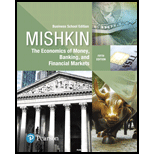
In case the question requires us to explain the three motives for holding money by Keynes in hid liquidity preference theory.
Concept Introduction:
Liquidity preference theory: Late Lord J. M. Keynes propounded the Liquidity Preference Theory to explain the interest rate determination with the help of
Liquidity is a term used to describe how quickly an asset can be converted into cash. If you keep the money in some other form of asset, or in bank, you will actually have a separation with the liquid form. Liquidity is the easiness of holding cash form of money rather than any other form. Interest rate is considered as the compensation for separation with the liquidity form of money.
Want to see the full answer?
Check out a sample textbook solution
Chapter 22 Solutions
Economics of Money, Banking and Financial Markets, The, Business School Edition (5th Edition) (What's New in Economics)
- Active Learning 4: Computing GDP Cookies 2021 (base year) 2022 2023 P Q P Q P Q $1 900 $2 1,000 $3 1,250 200 $1,200 210 Smartphones $900 185 $1,000 Use the above data to solve these problems: A. Compute nominal GDP in 2021. B. Compute real GDP in 2022. C. Compute the GDP deflator in 2023. Mankiw, Principles of Macroeconomics, 10th Edition. 2024 Cengage. All Rights Reserved. May not be scanned, copied or duplicated, or posted to a publicly accessible website, in whole or in part. 34 =4arrow_forwardDon't used hand raiting and don't used Ai solutionarrow_forwardI am having issue understanding how the chart is filled out and the answer are being created.arrow_forward
- The first question, the drop down options are: the US, Canada, and Mexico The second question, the drop down options are: the US, Canada, and Mexico The last two questions are explained in the photo.arrow_forwardcheck my answers, fix them if they are wrong. everything is in the picture. the drop down menus are either kansas or Illinois, except the last one which is yes or no.arrow_forwardeverything is in the imagearrow_forward
- everything is in the image!arrow_forwardRespond to isaiah Great day everyone and welcome to week 6! Every time we start to have fun, the government ruins it! The success of your business due to the strong economy explains why my spouse feels excited. The increase in interest rates may lead to a decline in new home demand. When mortgage rates rise they lead to higher costs which can discourage potential buyers and reduce demand in the housing market. The government increases interest rates as a measure to suppress inflation and stop the economy from growing too fast. Business expansion during this period presents significant risks. Before making significant investments it would be prudent to monitor how the market responds to the rate increase. Business expansion during a decline in demand for new homes could create financial difficulties.arrow_forwardPlace the labeled CS to represent the new consumer surplus in the market and the area labeled PS to represent producer surplusarrow_forward

 Principles of Economics (12th Edition)EconomicsISBN:9780134078779Author:Karl E. Case, Ray C. Fair, Sharon E. OsterPublisher:PEARSON
Principles of Economics (12th Edition)EconomicsISBN:9780134078779Author:Karl E. Case, Ray C. Fair, Sharon E. OsterPublisher:PEARSON Engineering Economy (17th Edition)EconomicsISBN:9780134870069Author:William G. Sullivan, Elin M. Wicks, C. Patrick KoellingPublisher:PEARSON
Engineering Economy (17th Edition)EconomicsISBN:9780134870069Author:William G. Sullivan, Elin M. Wicks, C. Patrick KoellingPublisher:PEARSON Principles of Economics (MindTap Course List)EconomicsISBN:9781305585126Author:N. Gregory MankiwPublisher:Cengage Learning
Principles of Economics (MindTap Course List)EconomicsISBN:9781305585126Author:N. Gregory MankiwPublisher:Cengage Learning Managerial Economics: A Problem Solving ApproachEconomicsISBN:9781337106665Author:Luke M. Froeb, Brian T. McCann, Michael R. Ward, Mike ShorPublisher:Cengage Learning
Managerial Economics: A Problem Solving ApproachEconomicsISBN:9781337106665Author:Luke M. Froeb, Brian T. McCann, Michael R. Ward, Mike ShorPublisher:Cengage Learning Managerial Economics & Business Strategy (Mcgraw-...EconomicsISBN:9781259290619Author:Michael Baye, Jeff PrincePublisher:McGraw-Hill Education
Managerial Economics & Business Strategy (Mcgraw-...EconomicsISBN:9781259290619Author:Michael Baye, Jeff PrincePublisher:McGraw-Hill Education





